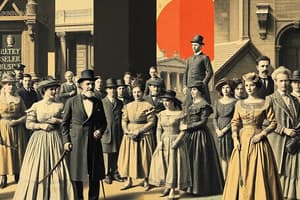Podcast
Questions and Answers
What was a common reason for people to leave 19th-century Dalmatia?
What was a common reason for people to leave 19th-century Dalmatia?
- Struggles with poverty (correct)
- Desire for adventure
- Political stability
- Cultural enrichment
Which empire controlled Dalmatia in the 19th century?
Which empire controlled Dalmatia in the 19th century?
- Venetian Republic
- Austro-Hungarian Empire (correct)
- Ottoman Empire
- Roman Empire
What aspect of life was emphasized in 19th-century Dalmatia?
What aspect of life was emphasized in 19th-century Dalmatia?
- Technology innovation
- Luxury and wealth
- Urbanization
- Hard work and tradition (correct)
Where did most people in 19th-century Dalmatia typically reside?
Where did most people in 19th-century Dalmatia typically reside?
Which of the following best describes the social structure in 19th-century Dalmatia?
Which of the following best describes the social structure in 19th-century Dalmatia?
Flashcards are hidden until you start studying
Study Notes
Rural Life and Farming
- Many people relied on farming and fishing as primary sources of sustenance.
- Small villages were common, fostering a close-knit community lifestyle.
- The agricultural practices were primarily subsistence-based, focusing on growing enough food for families.
Poverty and Moving Abroad
- High levels of poverty characterized life for most residents, making survival difficult.
- Many individuals and families emigrated in search of better economic opportunities, particularly to the Americas.
Political Struggles
- Dalmatia was part of the Austro-Hungarian Empire, leading to political centralization and limited local autonomy.
- Ethnic and national identities were a source of tension, influencing local governance and community relations.
Culture and Traditions
- Rich cultural traditions were maintained through folklore, music, and dance.
- Festivals and religious events were significant, often providing a sense of community and collective identity.
Family and Society
- Family structures were typically extended, with close cooperation in both labor and social life.
- Gender roles were prominent, with men primarily handling outdoor labor while women managed household duties.
City vs. Village Life
- Urban areas offered more opportunities for trade and commerce, contrasting with the rural focus on agriculture.
- Village life was marked by slower-paced living, with strong communal ties, while city life was more dynamic but less intimate.
Studying That Suits You
Use AI to generate personalized quizzes and flashcards to suit your learning preferences.




